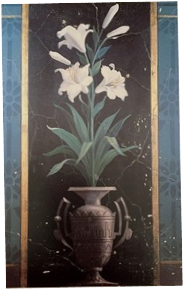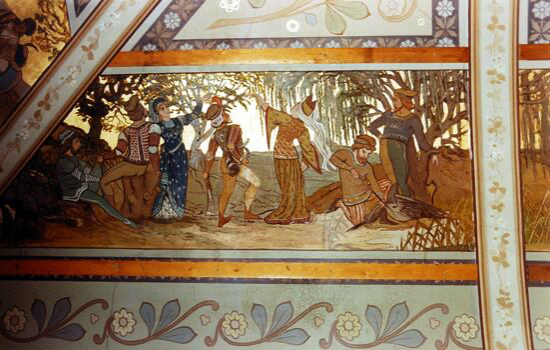Collingwood Notables Database
Ulysses Rizzi
1855-1902
Artist, decorator
Ulysses Rizzi was an acclaimed flower painter and decorator whose work may still be seen at Villa Alba in Kew and the Lady Chapel at St Francis Catholic Church in Lonsdale Street Melbourne. A resident of Victoria Parade, he also taught drawing at the Collingwood School of Design and Fitzroy School of Art.
Italian-born Rizzi arrived in Sydney, Australia in January 1878. He described himself as ‘from the Royal Italian Academy’, which probably means he studied at Regio Istituto di Belle Arti di Roma, so re-named in 1874 (now the Accademia di Belle Arte di Roma). He appears to have stayed in Sydney until he relocated to Melbourne in June 1879 and while there decorated Kincoppal in Elizabeth Bay. He took over the drawing class at the Fitzroy School of Art from Mr Vandenbrande in 1879; the two men shortly afterwards set up in business as ‘artistic painters and decorators’ in Eastern Arcade (Bourke Street) and before long needed an apprentice. Their business would have been given a boost by the large advertisement placed in December 1880 announcing the re-opening of Kitts’s Music Hall Eastern Arcade (usually known as the Apollo Hall) in which Mr Kitts:
has much pleasure in stating that the entire interior has been renewed and elaborately decorated in the modern Renaissance style by Mr. VANDENBRANDE and Sig, Rizzi
Rizzi had chosen a fortunate time to bring his talents to Melbourne, which was developing into a fully-fledged metropolis. The Melbourne International Exhibition, with its extraordinary array of products from around the world, was held in the new Exhibition Building in 1880; by 1883 Richard Twopenny’s Town life in Australia had dubbed Melbourne ‘the metropolis of the Southern hemisphere’, while the famous description ‘Marvellous Melbourne’ was coined by journalist George Augustus Sala in 1885. The population increased dramatically during the decade, suburbs expanded and building activity boomed. At the same time the art movement took hold:
All classes of society in this bright and prosperous land of the south are being gradually imbued with a desire and love for beautiful form and colour in the artistic arrangement and adornment of their homes.
The Argus 14 Oct 1882 p. 13
The well-to-do in particular strove to impress with elaborate artistic decoration. Two firms who specialised in such work were the Paterson Brothers, and Cullis Hill and Co. The latter firm hired artists Mr Vandenbrande and Signor Rizzi to paint the ceilings of the ballroom and drawing room of Ordsall in Kew in 1882. (Later re-named Southesk, the mansion was demolished around 1970 and replaced with City of Kew civic buildings; luckily photographs of the decorations survived). The same firm also hired the two to work on Landcox, a Brighton mansion, which ‘was painted with allegorical maidens, paintings of the owner’s daughters portrayed as cherubs; and decorations of fairies, butterflies and flowers. Scenes from European continental operas were painted by the commissioned artists Vandenbrandt, Rizzi and Brettschneider.’ In 1884 Paterson Brothers carried out the extraordinary mural and ceiling decorations of Villa Alba in Studley Park. Rizzi is credited with decorative work in the upstairs hallway, where the dado is decorated with naturalistic flower panels. It seems probable that he decorated other houses which remain undocumented.
Vandenbrande left Melbourne in 1884 for Sydney, to concentrate on portrait painting. Around this time Rizzi expanded his repertoire into church decoration for the Catholic Church in Melbourne. In 1884 he was responsible for the decorating and painting of the altar of the Blessed Virgin at St Brigid’s in North Fitzroy. Later that year the Lady Chapel at St Francis was transformed into a replica of the crib at Bethlehem, and ‘beautifully decorated by Signor Rizzi, a young Italian artist’. In following years another side altar, and the main altar, were added at St Brigid’s.
In 1887 he decorated the sanctuary of St Patrick’s Cathedral, and in 1890 he carried out decorations and gilding on the altar at St James in Elsternwick, and decorated the altar for St Martin’s Catholic Church in Muskerry (near Bendigo).
Rizzi had a busy year in 1891. He renovated the Stations of the Cross at St Patrick’s Cathedral and undertook decorations ‘principally in white and gold, with shadings of blue and French grey’ at a new church, Our Lady of Mt Carmel at Middle Park. Panels of the altar of the new Church of the Sacred Heart at East Trentham were adorned with four ‘beautiful oil paintings of the Evangelists, by Signor Rizzi, of Melbourne, who gives special attention to ecclesiastical art’, as noted in The Advocate. He also carried out elaborate re-decoration of the interior of St Francis’s Church, and decorated St Mary’s Church in Echuca. While there, his services were snapped up by Dobinsons the drapers to decorate their show rooms.
Finally he was commissioned to work on a local church, St Joseph’s in Otter Street Collingwood. The Sacred Heart altar and the Our Lady altar were described as ‘richly decorated by signor Rizzi’ in 1892.
His artistic endeavour also blossomed in the creation of the beautiful silk banners of trade unions, proudly carried in the Eight Hour Day procession. Rizzi is known to have completed banners for the Victorian Farriers Society, the United Society of Painters, Decorators, and Decorators, the Railway Laborers’ Union, and the Victorian Operative Bootmakers’ Union. This last group collected their banner from Rizzi’s premises in Victoria Parade and marched with it to Trades Hall for the Eight Hour Day procession. It is no surprise that all of the banners incorporated floral decorations, his speciality. He also painted a gorgeous banner for St Michael’s branch of the Hibernian Australian Catholic Benefit Society, first carried in the 1887 St Patrick’s Day procession.
All seemed to be going well for Rizzi, as a respected artist in the metropolitan area as well as his own locality. He lived and worked in a commercial stretch of Victoria Parade where he had purchased two timber shop/dwellings, sometimes letting one but apparently sometimes using both for his studio work and teaching. In 1885 he presented an oil painting of Captain Kay of the Simpsons Road Fire Brigade to be hung in their new building. As well as teaching at the Collingwood School of Design, he set up his own classes for ladies and gentlemen in all branches of painting, and in 1889 called for tenders for additions to his shop at 169 Victoria Parade. He participated in the social life of local clubs such as the Melbourne and Suburban Cosmopolitan Club in Fitzroy and the Crocodile Club, where at their annual fancy dress ball in September 1887 he attended as ‘an Irish nobleman, most gorgeously attired. The costume was very much admired’. References to artists and art teachers ‘taught by Signor Rizzi’ had begun to appear in newspapers.
In January 1892 he advertised for a boy to learn painting and decorating, but apart from the comment on his work on St Joseph’s Collingwood in May 1892, the many newspaper references to his work cease abruptly. What happened? Melbourne’s Boom Period had ended with the collapse of many of the city’s financial institutions in the early 1890s. In the economic downturn decorative artists became a luxury as many houses were empty, untenanted, or up for sale. Churches were using what funds they had to help the poor of their parishes, and the 1893 Eight Hours Day march proceeded without a single new banner. By 1894 the National Bank was listed as the owner of Rizzi’s two properties, hinting that the bank might have foreclosed on a mortgage.
Many artists at the time moved to Sydney, and Rizzi did so in April 1893. Re-location did not meet with success. On the contrary, while living in a lodging house in The Rocks in 1895 and 1896 he featured in police reports, arrested for being drunk and disorderly, and stealing, and received several short jail sentences. He was sometimes ‘deemed insane’ – probably indicating that he was suffering from delirium tremens brought on by sudden withdrawal from alcohol. From the reports we learn something about his appearance: black hair, brown eyes, fresh complexion, 5 feet 5 and a half inches in height, medium build.
It would be tempting to ascribe these problems to his economic and artistic setbacks in the 1890s, had it not been for a disturbing incident in September 1889 which might presage later developments:
ATTEMPTED SUICIDE. Ulysses Rizzi, a respectable looking man, was charged with attempting to commit suicide. William Rawyle, porter at the Essendon station, … was informed a man had jumped out of the 5.20 train from Broad meadows. … witness gave him in charge to Constable Minster ... he was bleeding from the left ear, and had a scalp wound-placed accused in the van and brought him to Moonee Ponds. Dr Flanagan subsequently recommended his removal to the Melbourne Hospital, where he remained till Saturday. Senior Constable Jones said he had made inquiries, and found that accused was a highly respectable man. He had been on a drinking bout prior to the escapade of the 20th. Accused was discharged.
North Melbourne Advertiser 4 October 1889, page 3
In January 1897 he returned to Melbourne. In 1898 and 1899 he established a studio at 52 Eastern Arcade, Bourke Street and advertised in the Church of England Messenger as a church decorator and general designer. The only further evidence of commissions are two houses for sale, Pine Hill in Hawthorn where in 1900 ‘the decorations throughout must command the admiration of all, having been carried out by Signor Rizzi, REGARDLESS OF COST’ and in 1908 Ardrie in Toorak, described as ‘recently decorated by Signor Rizzi’. But there is nothing concrete to show whether the work was undertaken in this recent period or before he left for Sydney.
Rizzi died in the Melbourne Hospital in early 1902 of a heart attack and alcoholism. The death certificate provides no information about parents, relatives or an address. A man who was lauded for the aesthetic pleasure he gave to so many, left this world, it seems, ignominiously and alone, to be buried in a pauper’s grave in the Roman Catholic section of the Melbourne General Cemetery.
Ordsall mural fragment
Life Summary
| Birth Date | Birth Place |
|---|---|
| 1855 | Milan, Italy |
| Home Street | Home City | Status of Building |
|---|---|---|
| 167 and 169 Victoria Parade | Collingwood | Demolished |
| Death Date | Death Place | Cemetery |
|---|---|---|
| 9 february 1902 | Melbourne | Melbourne General Cemetery |
https://recollections.nma.gov.au/issues/volume_8_number_2/papers/villa_alba#pageindex1
https://en.wikipedia.org/wiki/Accademia_di_Belle_Arti_di_Roma
Ulysses-Rizzi-Advertisements.pdf
Cummings, Bitter roots, sweet fruit
Davison, The rise and fall of Marvellous Melbourne
Montana, The art movement in Australia: design, taste and society 1875-1900
St Kilda Times, Dec 2015
Trove newspapers list: Ulysses Rizzi https://trove.nla.gov.au/list/157068
Australian Town and Country Journal; Sydney Morning Herald; The Argus; The Age; Bendigo Advertiser; Advocate;The Church of England Messenger for Victoria; Mercury and Weekly Courier; North Melbourne Advertiser; The Riverine Herald; Richmond Guardian; The Herald; Fitzroy City Press; Evening News (Sydney); Melbourne Punch; The Australasian; Leader; The Capricornian (Rockhampton).
Eastern Arcade emelbourne.net.au
St Patrick's Cathedral decorations 1887
Detailed description of Ordsall
PROV, VPRS 11486/P1 Technological Schools Letter Book Statistics, unit 1, no 22, Collingwood School of Art


